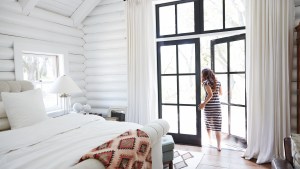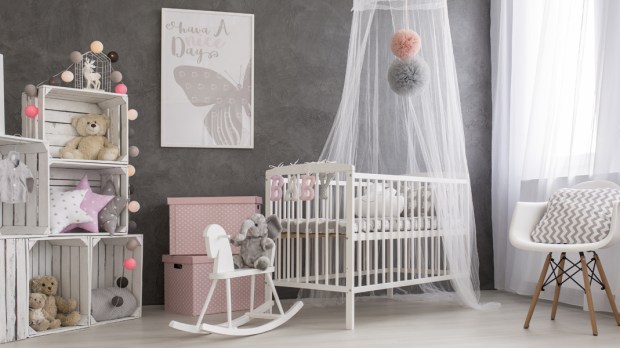When a baby first comes home from the hospital, he’ll spend most of his time snuggled up in his crib, softly snoozing — well, that’s the dream, anyway! But even if your kid isn’t a sound sleeper in those first few months, his room will be the primary space where he develops and grows. Like a cocoon, the room should be able to adapt to the baby’s needs and personality, whether the theme is happy elephants or cuddly white rabbits. And the baby’s room should also adapt to your needs as a parent.

Read more:
Turn your house into an oasis of peace: A room-by-room guide
So right from the start, the more thought you put into the nursery, the easier it will be to accommodate your new life and a growing baby. A great place to start, says French interior designer Claire Clerc, is to design a tailor-made room full of soothing decor and adaptable furniture that will allow you the time to focus on the essentials, like bonding with your little bundle of joy. Here are four points to keep in mind as you design:
1. A room that helps baby flourish
A newborn begins to blossom and open up to the world from the very first weeks of life. But, of course, the baby’s interactions are fairly limited to immediate surroundings in your home. That means it’s all the more important to design a room that will encourage the baby’s development.
“Looking at storage, boxes or baskets give children a level of autonomy,” points out interior designer Clerc. “With color codes (such as a blue basket for toy cars, a yellow box for soft toys, etc.), the baby quickly learns to recognize the use for each bit of storage, eventually taking out and putting back their toys by themselves.”
To nurture a child’s development, it’s also important to create a room adapted to a child’s height, meaning everything should be pretty close to the floor. (Annoying for mom and dad? Maybe a little. But just think how much good exercise you’ll get from doing those squats!) “A small mattress on the floor or a thick quilt with cushions, creates the perfect reading corner,” explains Clerc. “Some books on a carefully placed shelf just slightly higher up on the wall will encourage the baby to reach out and take them.”

Read more:
10 Beautiful biblical names to give your baby daughter
At the heart of the room, place a rug to mark out a space for playing. “A play rug helps develop a baby’s motor skills, while allowing the baby to grow in its room,” continues Clerc. “A special little space for them. After all the nursery needs to be more than just a place to sleep.”
2. Anticipate your baby’s development
The nursery needs to follow the baby’s growth and development, which is pretty staggering in those first few months. “Ideally you want to pick out furniture that can adapt with your baby’s growth and that can stand the test of time,” advises Clerc. Whether a bed, desk, or cupboard, choose furniture that transforms with the different steps of your baby’s life.
It is essential to consider these changes when considering where you’ll place each piece of furniture. The bed, for example, is a little cradle for the first few months, then becomes a crib with bars, then a normal bed after a couple of years. “When choosing a place for the baby’s bed think about if there will be enough space there when it becomes a larger bed,” recommends Clerc. “This familiar cozy little area will be a comforting point of reference to your growing child and it’s preferable not to move it.”
In the same way, a changing table is destined to disappear once your baby is potty-trained. “It’s better not to dedicate a crucial space for it, try looking at a [removable] wall-system instead,” suggests Clerc.
3. Think about the room’s layout for day AND night
The baby’s room is a place to flourish during the day, but a lot of parents forget that it also needs to be practical at night. That means comforts for the child as well as the mother. “I love the idea of having a comfy armchair in the room for those nocturnal wake ups,” says Clerc. You can choose a rocking chair to help the baby nod back off to sleep — even better if you manage to get your hands on one your grandma might have rocked your mom off to sleep in! (Good family juju means sweet dreams.) In the day you can sit on the chair while watching your child play on the floor, while you attempt to knit a beautiful sweater … or just take endless photos of your little angel!
When considering lighting for the room, night-lights are an obvious choice: They allow you to check up on your baby without bothering him. There are some very stylish options available everywhere from Babies R Us to Amazon that can add a touch of character to the room. For example, this sweet giraffe nightlight by Jonathan Adler.

Read more:
Baby slings to help you wear motherhood in style!
Also consider a layout that lets you move around the room with ease, without banging your toes on table legs or knocking over storage bins of toys. Place taller furniture against the wall by the door, the bed facing the entrance in the corner, and lower pieces of furniture running along the opposite wall. Avoid obstacles and furniture that cross the room, being dangerous for both you and your baby. Note: Make sure any furniture that is in danger of toppling on to your child is screwed into the wall and try to avoid any sharp corners that your baby may bang their head on.
4. Play with color
Babies love those bold, bright colors, which is why so many of their toys are designed with them. But come nightfall, babies will appreciate dozing off in a more peaceful environment. So in the area where the baby sleeps select soft and calming colors.
“Juggle with a range of tones (pastels, shades of blue, etc.) by applying natural hues on the walls and adding splashes of deeper colors elsewhere,” advises Clerc. “You can start off with wall-paper and bring out its colors with accessories, or decorations, for example.”
Color is a good way to bring structure to the room, too. “The sleeping, play, or reading area can be defined by different colored geometrical shapes, such as a triangle in one corner,” explains Clerc. A mineral blue wall, with a powdered pink square above the changing table, or a citrus yellow strip behind the reading area are some examples of ways you can play with color and shapes.
Before choosing the paint color(s) for your nursery make sure it is also suitable and safe for use in an infant’s room. “That means the paint must be non-toxic, natural if possible, without solvents, or giving off VOC (Volatile Organic Compounds),” recommends the designer. “For the finish, select a smooth paint, the most soft and washable is always the most practical.”

